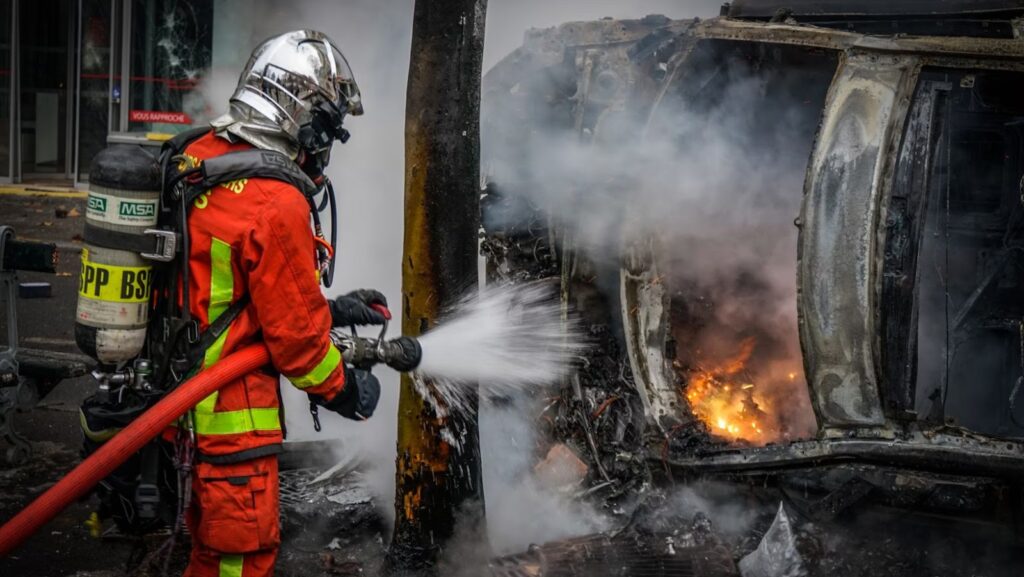In recent years, attention has increasingly turned to the environmental impact of aqueous film-forming foam (AFFF). It is a firefighting agent widely used by military and civilian fire departments worldwide.
While AFFF has been instrumental in combating fires effectively, its aftermath poses a significant threat to our water ecosystems. The persistence of per- and polyfluoroalkyl substances (PFAS), found in AFFF, has led to widespread contamination of water sources.
AFFF Contamination
AFFF contamination stems from the widespread use of firefighting foams containing PFAS compounds, which have been deployed in emergency response scenarios for decades. The EPA notes that these PFAS chemicals, including perfluorooctane sulfonate (PFOS) and perfluorooctanoic acid (PFOA), persist in the environment. This leads to long-term contamination of soil and water systems.
Once released, PFAS compounds leach into groundwater and migrate into surface water bodies, posing a significant threat to aquatic ecosystems. The extensive use of AFFF in firefighting training exercises and actual fire suppression operations exacerbates the dispersion of PFAS contaminants. This contributes to their widespread presence in water sources worldwide.
Environmental and Health Impacts
The environmental and health impacts of PFAS contamination are multifaceted and alarming. According to ATSDR, studies have linked PFAS exposure to adverse health effects, including liver damage, immune system suppression, and reproductive disorders. Wildlife, particularly aquatic species, are also vulnerable to the toxic effects of PFAS, with documented cases of reproductive impairment and developmental abnormalities.
Furthermore, the bioaccumulation of PFAS compounds in the food chain poses secondary risks to human health through the consumption of contaminated seafood. The pervasive nature of PFAS pollution underscores the urgent need for comprehensive regulatory measures and remediation efforts to mitigate its far-reaching consequences.
Legal Ramifications and Accountability
The emergence of the AFFF foam lawsuit reflects a growing recognition of the responsibility borne by manufacturers and users of PFAS-containing firefighting foams. Communities affected by PFAS pollution are pursuing legal action to seek compensation for damages incurred and to hold accountable entities liable for environmental degradation.
TruLaw notes that high-profile settlements and court rulings have highlighted the significant financial and reputational consequences facing companies implicated in PFAS litigation. As per the Lawsuit Information Center, one such example of a settlement is the $10 billion proposal made by 3M to resolve AFFF lawsuits.

Moreover, regulatory agencies are increasingly scrutinizing the activities of industries that utilize AFFF. This signals a shift towards greater accountability and oversight in the handling of these hazardous substances.
Regulatory Responses and Remediation Efforts
Governments and environmental agencies worldwide are implementing regulatory measures to address PFAS contamination and minimize future risks. These initiatives include bans or restrictions on the use of PFAS-containing products. They have also led to the establishment of water quality standards for PFAS concentrations in drinking water supplies.
Remediation efforts are also underway to remove PFAS pollutants from contaminated sites, employing techniques such as activated carbon filtration and soil remediation technologies. However, challenges persist in developing cost-effective and sustainable remediation strategies capable of effectively addressing the scale of PFAS pollution in affected areas.
The Call for Sustainable Alternatives
The adverse environmental and health effects associated with AFFF have spurred a growing demand for sustainable firefighting alternatives. Researchers and industry stakeholders are exploring novel formulations and technologies that offer effective fire suppression capabilities without relying on PFAS compounds.
Biodegradable foams, inert gas systems, and water-based extinguishing agents are among the promising alternatives being developed to mitigate the environmental footprint of firefighting activities. The transition towards sustainable firefighting practices represents a crucial step in safeguarding ecosystems and public health while ensuring the effective management of fire-related risks.
FAQs
What is the bioremediation of PFAS?
Bioremediation of PFAS involves using microorganisms to break down or transform per- and polyfluoroalkyl substances (PFAS) into less harmful compounds. This process harnesses the natural metabolic capabilities of microbes to degrade PFAS contaminants in soil, water, or sediment environments.
Is AFFF a carcinogen?
Aqueous film-forming foam (AFFF) contains per- and polyfluoroalkyl substances (PFAS), some of which are known or suspected carcinogens. Prolonged exposure to PFAS-containing AFFF has been linked to various health risks, including an increased risk of certain cancers.
Is AFFF synthetic?
Yes, AFFF is a synthetic firefighting foam formulated to extinguish flammable liquid fires. It contains synthetic surfactants, solvents, and fluorinated compounds designed to create a stable foam blanket on the fuel surface to suppress the fire.

In conclusion, the discourse surrounding AFFF pollution underscores the pressing need for proactive measures to mitigate its environmental and health impacts. Legal actions, regulatory responses, and remediation efforts are underway, yet challenges persist in addressing the widespread contamination.
The pursuit of sustainable alternatives reflects a collective commitment to safeguard ecosystems and public health from PFAS pollution. As stakeholders collaborate and innovate, it becomes clear that addressing this complex issue requires fundamental changes in firefighting practices. The journey towards a cleaner, safer environment demands persistent dedication and concerted action from all sectors of society.
